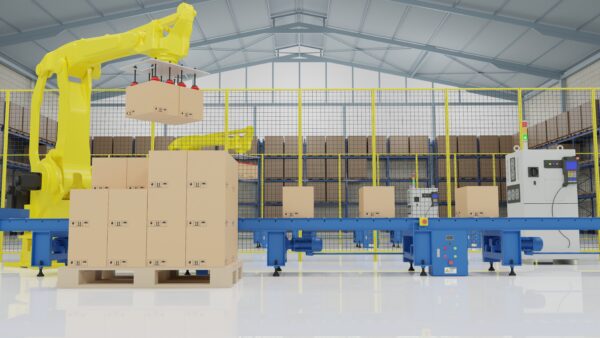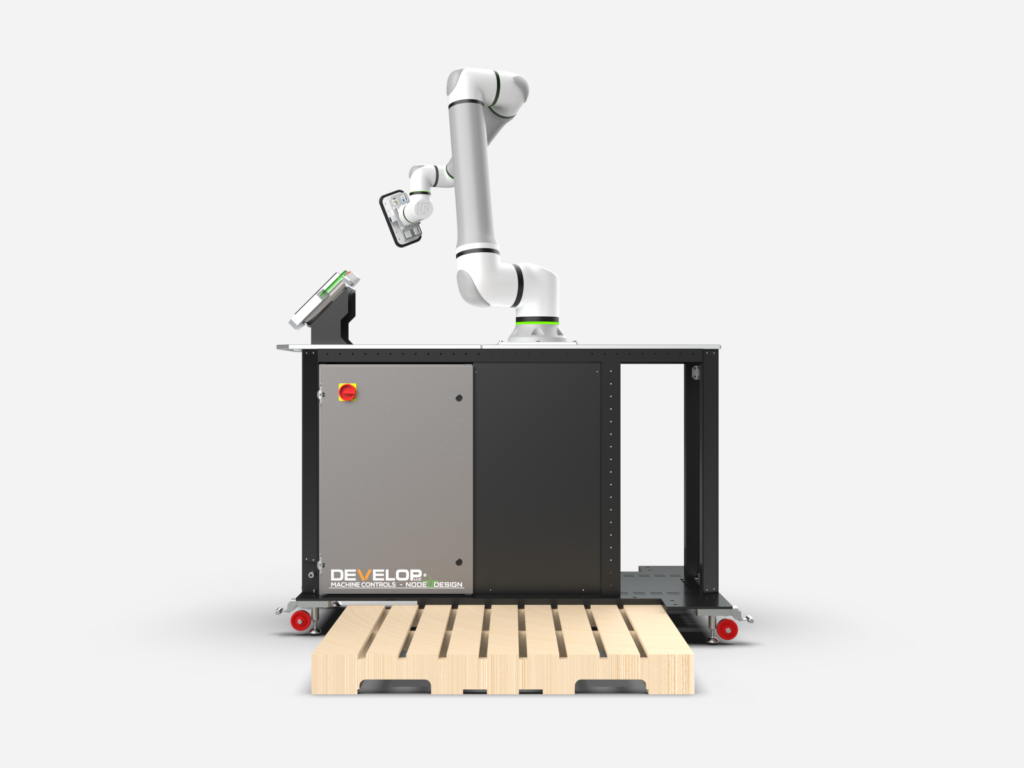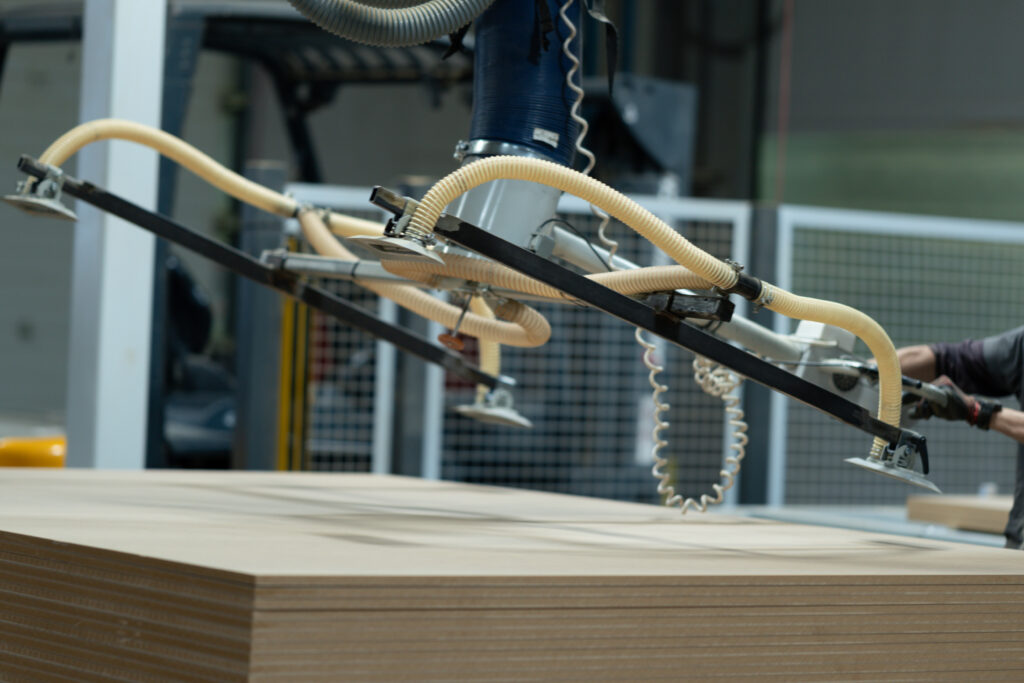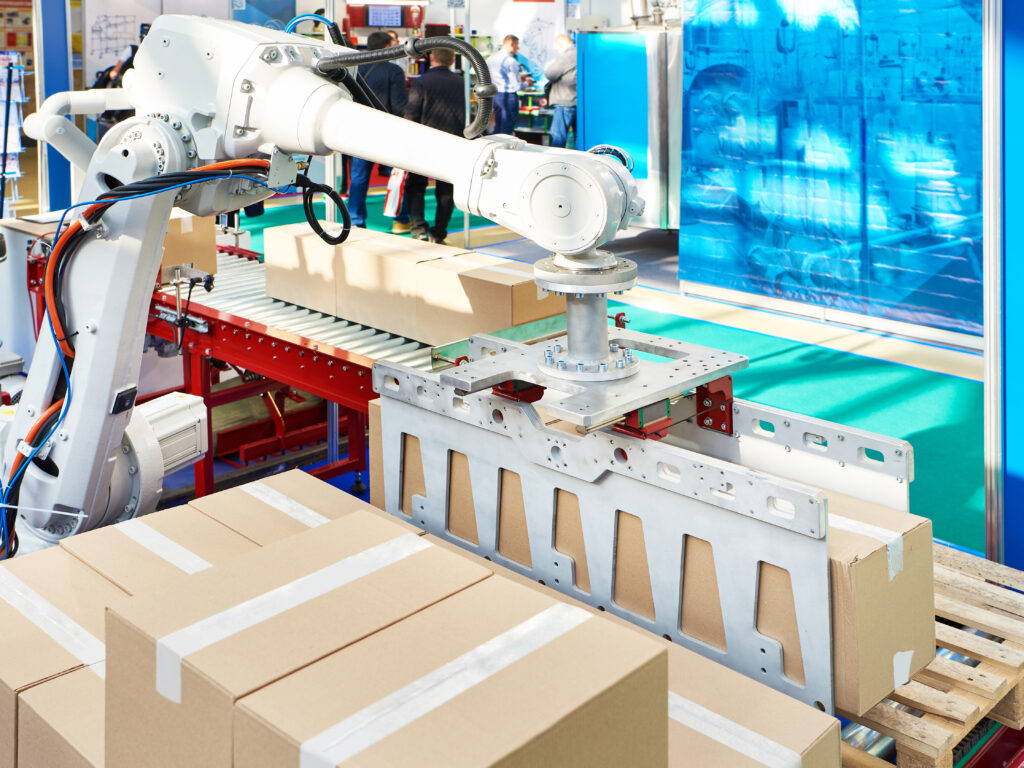There’s a growing trend in manufacturing automation adoption: successful industrial manufacturers integrating Robotic Palletizing Systems into their production lines. These targeted automated robotic solutions support end of line packaging and palletizing rather than trying to automate complete end to end manufacturing processes. We want to show you why so many are choosing robotic palletizing systems over complete automated systems.
The Challenges of a Complete Automation System Versus a Palletizer
An automated manufacturing line rarely starts with end to end lights out hands off robotic systems. Even though a custom automated systems integrator can design a machine that feeds raw stock, machines minute details, manufactures multiple stock keeping units (SKUs), picks and places your goods into containers, and loads them onto trailers, a good integrator will dissuade you from considering that as a first option. There are good reasons not to create the machine that makes everything:
- Engineering Cost- Every additional action included in the machine design has a logarithmic effect on engineering expenses. You could be looking at eight figures for a wide application everything machine.
- Engineering Risk- Every additional action included in the machine design logarithmically increases the chance for complication, change orders, and delays in delivery of the final machine.
- Risk+Cost=Time to Build- The more complex and risky the engineering, the more expensive the machine. That prolongs the time necessary for ROI.
Partially automated production allows manufacturers to reap the benefits of automated industrial manufacturing with a lower barrier of entry.
- Partially automated manufacturing requires lower upfront capital investment.
- A simpler machine with efficiently targeted tasks has less opportunity for engineering complication.
- Choosing specific bottlenecks in the production line, ergonomically challenging tasks, and repetitive tasks maximizes the speed of ROI.
Learn more: How to Apply 80/20 Principles to your Automation Integration
Robotic Palletizing Systems: A Walkthrough of the Ideal Targeted Machine Solution
Robotic Palletizing Systems represent the ideals of 80/20 targeted automation best out of most of the traditional types of industrial robots and automated machines. Lets walk through an iconic example Robotic Palletizing System:
- A Robotic Palletizing System usually consists of a sturdy base with an articulated robot arm attached. They typically comes in two types:
- Industrial Palletizers: Quick, powerful, palletizing machines. Excellent for high volume palletizing.
- Mobile systems: Nimble, redeployable robotic palletizers with cobotic palletizing capacity and speed.
- A Human Machine Interface (HMI), usually in the form of a console or touch screen device, allows the machine operator the ability to select different programs, adjust the arm for different package sizes, and monitor the system for data collection or quality control.
- An interchangeable end of arm gripper allows for a variety of function specific gripping styles such as vacuum powered gripping, mechanical grasping, or magnetic gripping.
- A series of precise sensors and detection devices cover the work envelope and directs the singulation and orientation of the arm.
- One or more pallet zones flank the robotic palletizing system for easy loading.
- The Robotic Palletizing System sits at the end of the manufacturing line, usually alongside a conveyor.
As sealed boxes come down the conveyor from the manufacturing line, the Robotic Palletizing System springs into action.
- The Robotic Palletizing System automatically detects the package size, position, and shape with sensors.
- The robotic arm carefully moves to grab the package off the conveyor belt, gripping it in the exact same place at the exact same speed every time.
- The arm swings the package over to the pallet, detects the available space, and places the box in the specific orientation from the program.
- The robotic arm moves back to the start position and awaits the next package.
Robotic Palletizing Systems: An Ideal First Automated Machine Solution
If you do not have a Robotic Automated System, you should consider integrating one into your manufacturing line.
Robotic Palletizing Systems: Agnostic to Industry
- Every industry needs to box, label, seal, and ship their products.
- Robotic Palletizing Systems simplify programming by focusing on singulation and orientation of the box rather than managing the engineering specific design of medical products, food products, rugged industrial parts, high volume printed circuit boards (PCB), and other function specific disciplines.
Robotic Palletizing Systems: Eliminates Undesirable Tasks for Workers
- Packaging and palletizing boxes is repetitive, ergonomically challenging, and fatiguing work.
- Packaging and palletizing has to be done in exactly the same way to precise orientation and singulation, the chance for worker errors and unnecessary variability increases as the eight hour shift comes to an end.
- Packaging and palletizing tasks have some of the highest turnover, lowest job satisfaction ratings, and least availability of qualified labor.
- Packaging and palletizing tasks are a primary source of repetitive stress injuries on the warehouse floor.
- Human error, injury, fatigue, and short staffing further complicate hiring with repetitive downtime, rework, and turnover.
- Robotic Palletizing Systems free up your staff for creative work, satisfying work, and the profit driven pursuits that grow a business.
Robotic Palletizing Systems: Industry Familiarity Eases Integration
- Since Robotic Palletizing Systems have become one of the most common methods of warehouse automation, they involve some of the lowest risks for custom engineering.
- Robotic Palletizing Systems have some of the most off the shelf options for parts, programming, and custom warehouse integrations.
- Off the shelf options, lower risks, modular integrations, and simple programming come with lower costs, quicker ROI, and shorter integration time.
Robotic Palletizing Systems: Versatile Functions
- Robotic Palletizing Systems can palletize boxes that weigh a few pounds or involve heavy duty arms that can lift thousands of pounds.
- They could work alongside people as collaborative robots (or cobots) with presence detection sensors and match human speeds.
- They could also be built to palletize multiple packages in seconds behind safety barriers.
- They can be programmed for multiple box sizes, some systems may even come on a mobile cart to redirect the palletizer to new lines.
- Accessories can expand a Robotic Palletizing System with labeling, box erecting, sealing, loading, depalletizing, single case palletizing, layer palletizing, upstream packaging and palletizing functions, and multilayer packing options.
- They are compatible with other post processing and end of line processing machines like Pick and place, Machine Tending, and Secondary Processing.
- They can be scoped for scalable modular additions, tool changers, and modular systems to accommodate picking different case sizes or orientations in the future.
Learn More: Cobots vs. Robots: What’s Right For You?
Robotic Palletizing Systems: Longevity
- Because of their general palletizing function, a Robotic Palletizing System is less likely to become obsolete due to market shifts, increased company growth, or advances in technology.
- Less complicated engineering in a Robotic Palletizing System versus a fully custom machine means lower chance of breakdown, more cost effective maintenance, and shorter maintenance downtime.
- User friendly self-programming options means it’s easier for operators to accommodate changes in packaging sizes, weight, or product shape.
Taking the First Step in Warehouse Automation
When you’re under pressure to choose an automation project with the least risk, lowest cost, fastest ROI, and most meaningful impact on your warehouse automation, it’s hard not to advocate for a Robotic Palletizing System. Capital investment involves risking reputation, loan fidelity, time, effort, the opportunity cost to pursue other ways to improve revenue in your business. You need to guarantee that the solution you pick improves quality, productivity, consistency, revenue, safety, employee satisfaction, employee retention, efficiency, and the work environment as a whole.
- You get the opportunity to save money on your production while significantly improving your production.
- You get the swiftest ROI to achieve pure profit.
- You solve the most common bottlenecks in end of line processing.
- You merge user friendliness and versatility with longevity.
- You provide a stepping stone for the next automation project.
Learn More: Automation Assessment
DEVELOP LLC’s experienced team of engineers, manufacturing experts, and project managers know how to guide you to the automated solution that makes the most sense for your business. Whether you are looking to expand into warehouse automation with a Robotic Palletizing System or seeking a fully custom automated manufacturing line, our experts can guide you to a practical solution that puts dollars back on your bottom line.
Tell us more about your project, schedule a virtual meeting, or call (262)-622-6104 to discover how we can integrate a robotic or automated system that will create the growth you need to reach an entirely new level of competition.
When you work with DEVELOP LLC, the game changing technology that changes your life is a day at the office.
About the Authors:
Matt Moseman leads as President of DEVELOP, with a strong foundation from the Milwaukee School of Engineering, where he earned both a Bachelor’s and a Master’s in New Product Management. Moseman’s career highlights include his pivotal role in founding NodeUDesign, innovating in automation hardware, and driving DEVELOP LLC to the forefront of industrial robotics with a focus on enhancing productivity and efficiency.
Sean McKittrick, as Project Program Coordinator at DEVELOP LLC, brings a multifaceted background from Knox College. McKittrick’s first year at DEVELOP LLC has been marked by significant team growth and zero turnover, showcasing his ability to build a collaborative and effective work environment. His experience spans quality management in healthcare software to managing production for a million pounds of material monthly, highlighting his diverse expertise in project coordination and manufacturing excellence.




